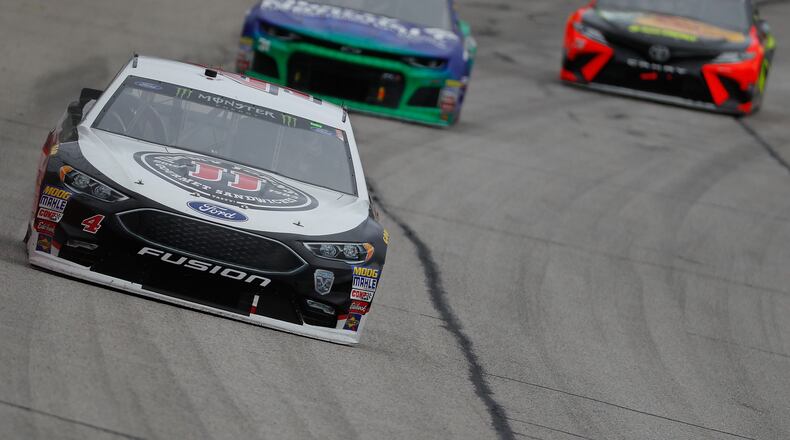Certain qualities of the big-time race-car driver are self-evident. Hand and eye need to be in instant agreement. It helps if reflexes are as tight and tuned as harp strings, and if concentration is as unbreakable as a new-car lease agreement. And, if you can go 190 mph while practically in the other guy’s watch pocket without creating some nasty in-car cleanup for your pit crew, that’s good, too.
There’s one other trait to consider, courtesy of an actual big-time driver.
“Adaptability is probably the most important,” Brad Keselowski mentioned before last week’s Daytona 500.
“It coincides with other great characteristics, but adaptability is what gives you the power to sustain in this sport,” he said. “The rules are always changing. Seems every year there is a rules change to talk about and we go ‘Oh my goodness, another rule change, this one will really change the game.’ Look back at the press clippings from the last dozen years and we’ve said the same thing.
“Some drivers are able to keep up with it and some guys aren’t. I look at a guy like Jeff Gordon, he adapted so well to multiple rules packages and it was a real testament to his staying power and success. That is what makes him a Hall of Fame driver.”
They are going to be adaptin’ all over the place this weekend at Atlanta Motor Speedway.
Another rule change has been decreed, this one meant to alter the very look and feel of the competition. And it is scheduled to debut Sunday at the Folds of Honor QuikTrip 500 at a speedway near you.
Nobody was particularly keen to see another race like last year’s at Atlanta, in which Kevin Harvick got out front and pretty much stayed there, crossing the finish line with a four-second margin of victory (otherwise known as half a lifetime in racing terms). A new set of alterations to the setup of these cars – tinkering with the rear-end spoiler and the front-end airflow to the engine – is meant to limit horsepower and see to it that everyone remains in the typical Atlanta traffic formation: The jam.
Last week’s Daytona 500 was its own separate beast, so it’s Atlanta’s place to be the first test track for the latest attempt to reinvigorate the sport. Going forward, the car setups are to be tailored to that week’s track, in an effort to improve the quality of racing.
If the changes work as they’re supposed to, AMS general manager Brandon Hutchison said, there would be more three-wide racing, more passing for the lead than in the past. “Not the pack racing you see at Daytona or Talladega,” he said, “but more side-by-side racing, drivers running two or three grooves on the track.”
“There’s a strong opportunity to see some of the best racing in Atlanta in the last couple of years,” Hutchison said.
“Obviously,” driver Kyle Busch said, “what we’re all looking for is not the six-second separation between first and second, which is too great of a distance to create any kind of excitement. If you can see anybody in front of you within three or four lengths then there may be an opportunity to get that guy somehow, some way.”
In a sport in which viewership and turnstile counts are on a steep decline – average TV viewership for NASCAR’s premier series has fallen by nearly five million in the past 13 years according to Sports Business Journal – there is a constant push to create interest. So this year, the answer was to institute something called the “tapered spacer” to control airflow to the engine and thus control horsepower, as well as making changes to the aerodynamics of the car meant to stabilize handling. For those in the audience who aren’t mechanical engineers, that is meant to translate into more competitive racing.
Such changes certainly have the drivers’ attentions coming to Atlanta.
“It should keep things tighter, but is it really going to be something where it’s easier to pass the leader?” wondered Daytona 500 winner Denny Hamlin. “That’s going to remain to be seen.”
There’s a lot of wondering going on, so Hamlin believes it best to rely on some basic advice his daddy gave him: “He said you’re still going in a circle, you still have to get off the corner well and you got to figure out how to make it happen. It’s no different with the rule changes – high downforce, low downforce, whatever, you still have to be able to get around the race track as fast as possible. The great drivers figure that out quicker than others.”
As for the look of racing at Atlanta, Ricky Stenhouse Jr. surmised: “Harvick wins so much there on the bottom, but taking some horsepower away, adding some downforce, I think that will open the track up to be able to use a bit more lanes – top, bottom, middle. I’m hoping the racing will be better. I feel the racing is always pretty good at Atlanta, but I do think it might be a little bit better than it normally is.”
Restarts after a caution are going to be a bit more manic now, they seem to agree.
The chances for a runaway are reduced, they think.
Otherwise, “I have no clue (about the effects of the new package), and if anybody tells you they have a clue they’re lying,” Harvick said.
“Are you going be able to get close enough to actually bump draft? Can you actually stay hooked together? There are just so many questions to answer that we don’t have any answers to other than theory,” he said. “We just need to race to really start crossing things off the list and have a direction to know what we’re working on past the theory.
“I can only guarantee it will be drastically different.”
It is the natural order of things in NASCAR. Adapt, or become lapped traffic.
About the Author
Keep Reading
The Latest
Featured




